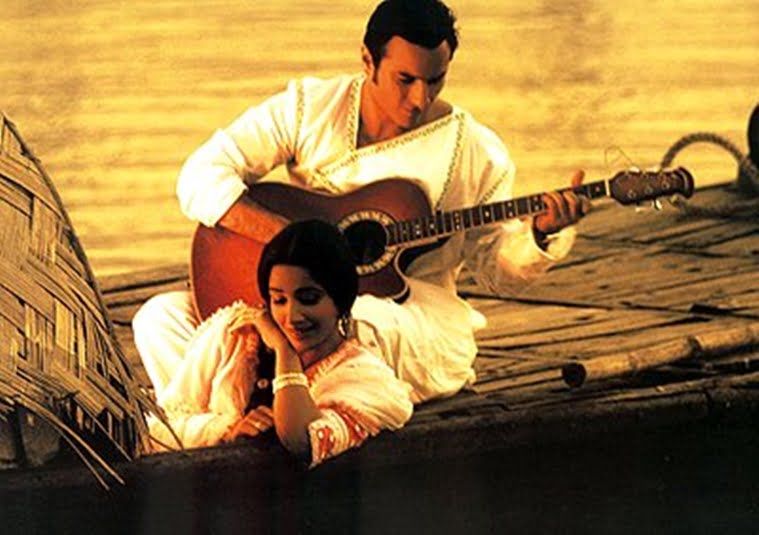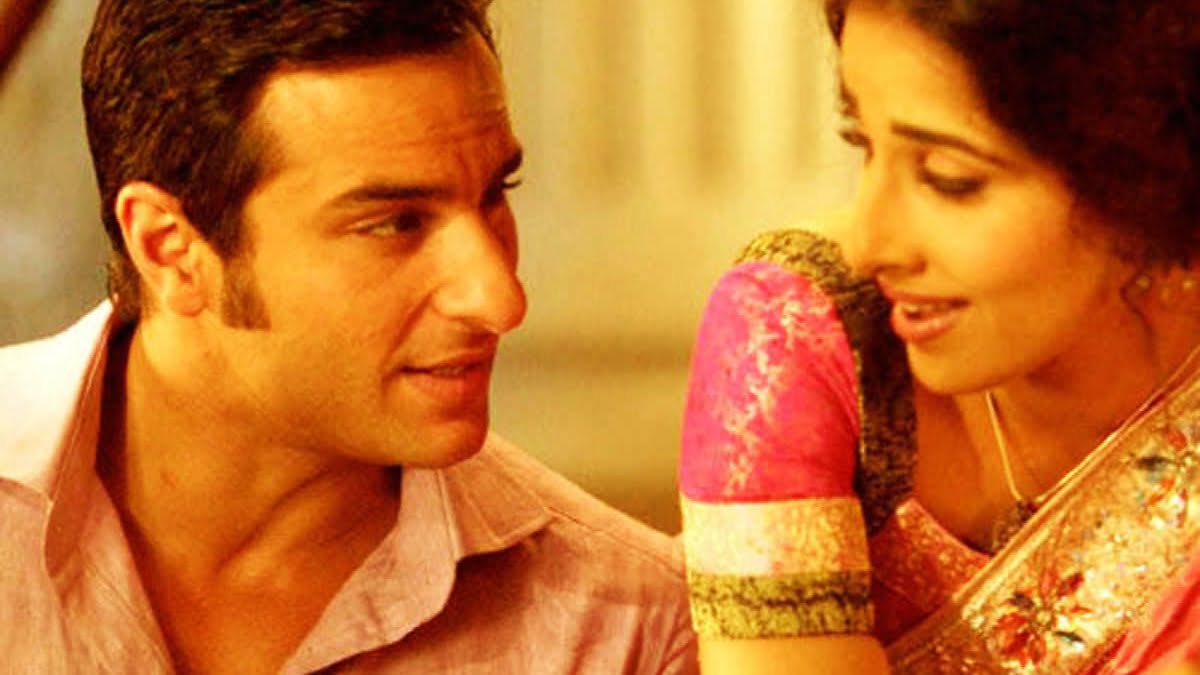Nineteenth century Bengal is an oft-traversed domain because of mainstream cinema like Devdas, Chokher Bali and Parineeta.
Parineeta (2005) meaning Espoused, is an adaptation of the Sarat Chandra Chattopadhyay novella of the same name. The screenplay, architectural landscapes, costumes, colour palette, everything in Parineeta helps define a specific Bengali space and characters by drawing on widely known traditions and explicitly portraying specific cultural practices which are recognisably Bengali. The sound in Parineeta also reworks the audience’s sense of space and time by adding another layer to the visual portrayal of a setting (Kolkata) through music (overt references to Tagore’s compositions). It demonstrates a strong cultural affiliation. Although a commercial film, Parineeta functions as a site where against all odds, a Bengali identity is maintained, and it remains central to the plot. The politically progressive and modern Shekhar, portrayed by Saif Ali Khan, however, is still an enabler of patriarchy. This essay attempts to juxtapose the traditional yet enlightened Bengali bhadralok in Parineeta against his conservative, patriarchal ideals.
Although a commercial film, Parineeta functions as a site where against all odds, a Bengali identity is maintained, and it remains central to the plot. The politically progressive and modern Shekhar, portrayed by Saif Ali Khan, however, is still an enabler of patriarchy. This essay attempts to juxtapose the traditional yet enlightened Bengali bhadralok in Parineeta against his conservative, patriarchal ideals.
The bhadralok referred to the traditional literati, drawn from the upper-caste population of pre-colonial Bengal. The term is multivalent but means most of all ‘gentle folk’ as opposed to chottolok (subaltern). Yet, in reality the definition of the Bengali bhadralok identity is much more complex. For starters, it is not a monolithic entity. It is not a consistent category that one can be fit into and with democratisation in Bengal, it has ceased to be an exclusive category. The identity also comes in more than one avatar. The late Ritwik Ghatak’s classic, Meghe Dhaka Tara, has a portrait of an old teacher of Sanskrit who comes as a refugee to Calcutta from East Bengal, which has recently become the eastern part of Pakistan. He is neither a civil servant nor a businessman, but by virtue of his thirst for knowledge and love of Sanskrit and more importantly, his upper-caste Hindu Brahmin identity accords him the status of bhadralok.
Academic prowess, rational-thinking and intelligence are said to be the important components of the bhadralok’s collective self-perception. Often involved in Leftist politics and high-art movements, they vehemently questioned status-quo as part of their ideals. They were said to have brought urban modernity into private spheres. Yet, it should not be forgotten than the reforms brought about by the Bengali enlightenment leaders and renaissance men still continued to relegate women to a subordinate status. Yet, the bhadralok unfailingly considered itself to be progressive, modern and intellectual.
Also read: The ‘Female Gaze’ In Satyajit Ray’s Charulata (1964)
In Parineeta, Shekhar rebukes Lolita for projecting a ‘loose’ character, while being a married woman. Without delving much into the plot of Parineeta itself, in sum, Shekhar puts himself on a pedestal and despite his cosmopolitan values, his worldview is still dismally rooted in patriarchy.
These traits were pervasive in the characterization of Shekhar in Parineeta. Politically progressive, cosmopolitan – he listened to Elvis and wore imported clothing. He addresses his concerns about Jawaharlal Nehru’s speech in the United Nations General Assembly but at the same time, is not beyond admonishing Lolita, calling her a characterless woman out of anger and frustration, a woman he loved and wanted to cherish for life. Coy, docile, vivacious and all things feminine – Vidya Balan’s Lolita was depicted as the ideal woman in Parineeta. Yet, she is not beyond the clutches of patriarchy and the benevolent, selective progressive patriarchal structures, when it came to her dignity and self-respect.
Coy, docile, vivacious and all things feminine – Vidya Balan’s Lolita was depicted as the ideal woman in Parineeta. Yet, she is not beyond the clutches of patriarchy and the benevolent, selective progressive patriarchal structures, when it came to her dignity and self-respect.
Although a relatively mild example from Parineeta, this reveals the conundrum within the identity of the bhadralok. Progressiveness and intellect was often overtly exaggerated by the bhadralok to notoriously compensate their sense of discrimination. Patriarchal hegemony ran deeper in Bengal’s social fabric than the bhadralok would like to admit. The bhadralok who tried to mirror the Victorian elite felt ‘burdened’ with the enlightenment and emancipation of women from ignorance. They assumed the task of such liberation and yet there was significant debate over the extent of which women should be educated and allowed free movement in society. However, what they all agreed on, was the need to eradicate what they were trained to believe was the pernicious influence of certain prevailing literary and cultural forms on Bengali women, particularly on the women belonging to their own homes.
Paradoxically enough, it is this same fold of bhadraloks from which the likes of Ram Mohan Roy and Ishwar Chandra Vidyasagar emerged, who tried to uplift the status of women in society. But even the model of female education popularised by the Brahmo Samaj emphasised on the cultivation of genteel norms and domestic virtues among respectable women. Their liberal attitude stretched outwards but women of their own households were exempted from it.
According to Sumanta Banerjee’s paper Marginalization of Women’s Popular Culture in Nineteenth Century Bengal, one leading weekly – Somaprakash in April 1864 reported: “Wherever there are sangs (pantomimes, lampooning familiar social types) and farces, you’ll find the vulgar masses, children and women.” The same paper, referring to the decline in the popularity of kathakata (reading mythological stories in the colloquial language, often in contemporary terms of reference) among the sushikshita dal (well-educated groups), commented: “… only women and the lower orders are its (i.e. kathakata’s) admirers.. .” These remarks reflected the attitudes of educated Bengali men towards women’s emancipation. They looked down upon their own women and tried to suppress their indigenous forms of popular culture by referring to those as obscene and trying to wean the women population off it.
Even in the process of this apparent emancipation, women were stripped off of their independent aspirations and were obligated to fit into a strictly chaste and domestic mould.
Parineeta depicts the reality of the so-called progressive thinking bhadralok, who no matter how liberal and cognizant, obsesses over fitting the women in his life within the uncompromising patriarchal mould.
Also read: To The Bhadralok Academia, With Love

In Parineeta, Shekhar rebukes Lolita for projecting a ‘loose’ character, while being a married woman. Without delving into the plot of Parineeta itself, Shekhar puts himself on a pedestal and despite his cosmopolitan values, his worldview is still dismally rooted in patriarchy. We see in Parineeta that Shekhar loves Lolita despite their class differences and her indifference towards Shekhar’s high society interests. He loves her because she’s the “ideal woman”. When a misunderstanding occurs, Shekhar flies into a rage without considering the complexities of Lolita’s situation, not inquiring what led her to take certain decisions because suddenly she was not the ideal woman he had perceived her to be, anymore. Her decisions assert her sovereignty and morals which is beyond Shekhar’s understanding. Parineeta depicts the reality of the so-called progressive thinking bhadralok, who no matter how liberal and cognizant, obsesses over fitting the women in his life within the uncompromising patriarchal mould.
Featured Image Source: Times Of India
About the author(s)
Sara Bardhan is an undergraduate student; lover of Manto, cheese and intersectional feminism.




